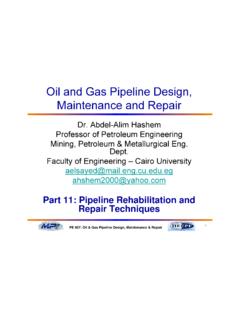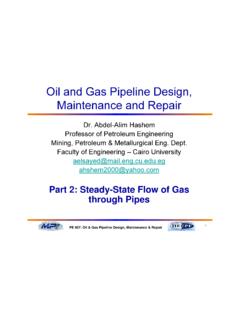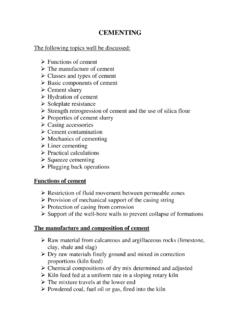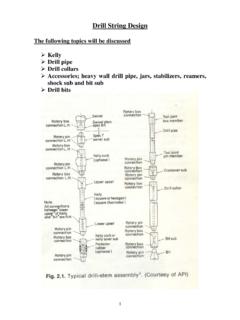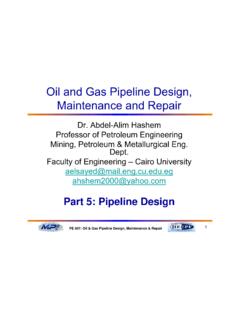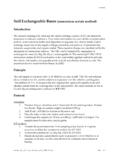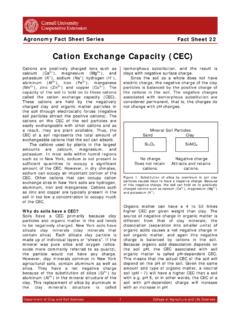Transcription of MUD ENGINEERING This chapter covers the …
1 1 MUD ENGINEERING this chapter covers the following items Function of drilling mud Drilling mud Types of drilling mud Water base mud Oil base mud Emulsion mud Fundamental properties of mud Mud calculations Mud contaminant Mud conditioning equipment Function of drilling mud Cool bit and its teeth Drilling action requires mechanical energy in form of weight on bit, rotation and hydraulic energy Large part of energy dissipated as heat Heat must be removed to allow drilling Mud helps remove heat Mud helps remove cutting between the teeth and prevent bit balling Cool and lubricate drill string Rotating drill string generates heat Mud help dissipate heat from hole Mud absorbs heat by convection and release it by radiation Mud lubricate drill string and reduce friction Control formation pressure For safe drilling.
2 High formation pressures must be contained within the hole to prevent damage and injury this achieved by hydrostatic pressure of mud Mud pressure should be higher than formation pressure 2 An overbalance of 100-200 psi is used Pressure overbalance id referred as chip hold down pressure (CHDP) Penetration rate decreases as CHDP increases For abnormal pressure CHDP becomes negative and kick will happen Carry cutting to surface Cutting generated by the bit must be removed Drilling mud carries cutting form bottom to surface Carrying capacity depend on annular velocity, plastic viscosity and yield point of mud and slip velocity of generated cutting For power law fluid, slip velocity is.
3 () = Dp = Particle diameter, in or mm p = Particle density, ppg, g/l m = Mud density, ppg, g/l e = Effective viscosity, cp Annular velocity Vr is the flow rate divided by the annular area Lift velocity V = Vr - Vs The mud also must suspend cutting when drilling stops Stabilize the wellbore Good mud cake stabilize the hole Differential pressure between mud and formation keep hole stable Reduce drilling time also help keep hole stable () = 3 Help in evaluation and interpretation of well logs During logging mud fill the hole Logs used to detect hydrocarbon, measure porosity, formation pressure Mud should posses properties that help evaluate these properties Drilling mud Fresh water gives a pressure gradient of psi/ft Normal formation pressure gradient is psi/ft Fresh water can not control formation pressure Solids are added to increase water density to control pressure Types of drilling mud Water base mud Consists of.
4 Liquid water, continuous phase Reactive solids, for viscosity and yield point Inert solids, for density Chemical additives, to control properties Reactive solids Clays are added to provide viscosity and yield strength Mechanism is very complex Internal structure of clay particles and electrostatic forces develop viscosity Two types of clay are available Bentonite clay, montmorillomite (smectite) group used with fresh water Attapulgite clay, salt gel (playgorskite) group of clay used in fresh and salt water Nature of clay Defines as natural, earthy, fine-grained material that develop plasticity when wet Form from chemical weathering of igneous and metamorphic rocks Mainly form from volcanic ash 4 Wyoming bentonite is the famous one Atoms from layers There are three atomic layers.
5 Tetrahedral layer, octahedral layer, and exchangeable layer Tetrahedra made up of flat honeycomb sheet made up of silicon atom surrounded by four oxygen Tetraherdra are liked to form sheet by sharing three of their oxygen atoms Octahedral layer are sheets composed of linked octahedral, each made up of an aluminium and magnesium atom surrounded by six oxygen They linked through oxygen making three octahedra Exchangeable layers of atoms or molecules bound loosely into the structure giving the clay its physical properties The nature of these layers are stacked together on top of one another define the type of clay The sandwiches of tetrahedral and octahedral layers are joined with exchangeable layer Distance between layers are 9-15 Angstrom units ( mm) In some clays, the exchangeable layer is relatively tightly bound in the structure Cation exchange capacity (CEC)
6 Measures how readily exchange take place CEC measured by dispersing a known amount of clay in a solution of magnesium chloride to replace as much as possible the exchangeable layer with magnesium It then transferred to a solution of potassium or calcium chloride The amount of potassium or calcium absorbed by clay is measured The amount is expressed in milliequivalents per 100 gm of dry clay and called (CEC) Typical values of bentonite are 70-130 and for attapulgite 5-99 CEC used as a guide to the quality of clay Hydration of clay Clays with high CEC exchange large amount of water into the exchangeable layer and adsorb water onto the outer surface of plates this effect gives high viscosity and high yield point 5 Adsorption of water causes a very sticking expansion of clay For sodium bentonite.
7 The distance between layers increased from to 40 Angstrom For calcium bentonite from to 17 A Overall hydration transform clay from dry power to plastic slurry The effectiveness is measured by yield of clay Yield of clay is defined as the number of barrels of 15 CP mud obtained from 1 ton (2000 lb) of dry clay Clay yield depends on: purity, nature of atoms in exchangeable layers and salinity of water Bentonite or attapulgite Bentonite consists primarily of montmorillonite Came from French town Montmorillon, where first mined 1874 Basic structure is close to pyrophllite. There are a small number of exchangeable ions, sodium calcium and magnesium Most common bentonite are those with sodium and calcium as exchangeable ions Attapulgite belongs to a different family of clay minerals Instead crystallizing as platy crystals, it forms needle like crystals Have excellent viscosity and yield strength when mixed with salt water Disadvantage is suffering high water loss and poor sealing properties Dispersion, flocculation and defloccullation Agitating of clay suspension in water gives three modes: edge to edge; face to edge.
8 And face to face Dispersion occurs with no face or edge association It results in increase in viscosity and gel strength Aggregate occurs with face to face association Aggregate results in a decrease in viscosity and gel strength Flocculation occurs with face to edge association It causes excessive gelation Flocculation can be broken by chemical thinners The resulting suspension is called deflocculated 6 Inert solids Include low gravity and high gravity Low gravity include sand and chert High gravity are added to increase mud weight or density Referred to as weighting materials Mud named as weighted mud, they are: Barite (barium sulphate, BaSO4) Used to prepare mud in excess of 10 ppg Referred to as weighting agent for low cost and high purity Lead sulphides (galena) Allowing mud weight up to 35 ppg Iron ores, sp.
9 Gr. 5+ More erosive Contain toxic materials Chemical Additives Used to control mud properties Divided into thinners and thickeners Mud thinners Reduce viscosity by breaking attachment of plate through edge or face by attaching the clay plates Phosphates: sodium tertaphosphates (Na4P3O7) and sodium acid pyrophosphated (Ba2H2P3O7), Suitable for any pH value, Limited to 175 F (70 C) Chrome lignosulphonate: Decomposes at 300 F (149 C), deflocculate and disperses clay, Reduce viscosity, yield strength and water loss, chrome lignosulphonate attaches to broken edges of clay reduces the attractive forces, Lignite: Decompose at 350 F (177 C), can be used as water loss agent 7 Surfactants (surface tension reducing agent): Reduce water loss, Used as emulsifiers in oil base mud Mud thickeners Lime or cement: Increase viscosity by flocculation resulting from replacement of Na+ cations by Ca++ cations Polymers.
10 Large molecules made up of many repeated small units called monomers Used for filtration control, viscosity modification, flocculation and shale stabilization Cause little change in solid contents of mud Polymer mud have high shear-thinning ability at high shear rate this reduces viscosity and in turn frictional pressure loss Hydraulic bit horse power increases and in turn penetration rates Three types are available: Extenders: sodium polyacrylate, increases viscosity by flocculating bentonite Colloidal polymer: CMC, HEC and starch o CMC: an ionic polymer produced by treating cellulose with caustic soda and monochloro acetate, molecular weight ranges between 50,000 and 400,000 o HEC: similar to CMC but hydrate in all types of salt waters o Starch: produced from corn or potatoes, molecular weight up to 100,000, used to develop viscosity and act as filtration control agent o Control filtration by forming sponge like bags wedges into the opening of the filter cake, disadvantage is that it is amenable to bacterial attack at low pH Large chain polymer.
